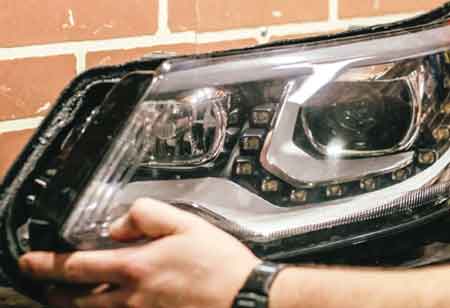THANK YOU FOR SUBSCRIBING
THANK YOU FOR SUBSCRIBING
Be first to read the latest tech news, Industry Leader's Insights, and CIO interviews of medium and large enterprises exclusively from Auto Tech Outlook

By
Auto Tech Outlook | Tuesday, June 24, 2025
Stay ahead of the industry with exclusive feature stories on the top companies, expert insights and the latest news delivered straight to your inbox. Subscribe today.
Remanufactured automotive lighting assemblies are gaining increased attention. The components such as headlights, taillights, and fog lamps are removed from end-of-life vehicles, restored to meet or exceed original specifications, and reintroduced into the market at a lower cost and reduced environmental impact. Promoting vehicle recycling and return initiatives can enhance the availability of essential parts. It's crucial to conduct educational and awareness campaigns, ensuring that consumers and repair professionals recognize the environmental and economic advantages of using remanufactured components.
Providing technicians with training programs is vital for informing them about the most current tools and techniques for managing advanced lighting systems. Ongoing education can lead to improved service quality and better safety outcomes. From cutting-edge technology integration to market trends and challenges, the remanufactured lighting sector is a dynamic space with significant potential. By fostering a greater understanding of these practices, the automotive industry can not only boost the usage of sustainable parts but also enhance overall repair processes, benefiting both the environment and the consumer.
Unlocking Potential with Latest Innovations
Several factors, including environmental policies, cost considerations, and the increasing complexity of modern lighting systems, influence the remanufactured automotive lighting market. Consumers and fleet managers seek affordable, sustainable options that don't compromise performance or safety. Remanufactured lighting assemblies provide a viable solution, especially for older vehicle models where new OEM parts may be scarce or costly.
The most prominent application of remanufactured lighting assemblies is vehicle repair and maintenance. Insurance companies often approve remanufactured components for collision repair due to their cost-effectiveness and reliability. Independent garages and body shops also favor these parts for budget-conscious customers. Fleet operators, in particular, benefit from the reduced total cost of ownership and consistent performance of remanufactured lighting systems.
Technology plays a pivotal role in the remanufacturing process. Advanced diagnostics are used to assess the functionality of electronic control units within lighting assemblies, while automated systems disassemble and clean components with precision. Optical calibration tools ensure beam accuracy and alignment. In the case of LED and HID lighting, specialized testing equipment verifies lumen output and thermal management functionality. Data analytics and AI optimize sourcing, inventory management, and quality control.
Lighting the Future: Remanufacturing Revolution Unleashed
The remanufactured lighting sector is rapidly evolving, shaped by consumer behavior, supply chain dynamics, and technological innovation. One major trend is the increased demand for innovative and adaptive lighting systems, such as matrix LED headlights. As these systems become more common in vehicles, the complexity of remanufacturing them increases. Their higher original cost makes remanufacturing financially viable and attractive to buyers. Companies are investing in more sophisticated capabilities to handle these components.
The shift increases accessibility and boosts customer trust, especially when backed by warranties and return policies. Partnerships between OEMs and third-party remanufacturers are beginning to emerge, where manufacturers supply guidelines or components to ensure quality and brand alignment. The remanufactured automotive lighting market faces significant challenges. Quality assurance remains a top concern, particularly when dealing with electronics and advanced sensors embedded in modern lighting systems. Without standardized regulations across regions, the quality and safety of remanufactured parts can vary widely.
The lack of consistency creates uncertainty among consumers and repair professionals. As vehicles become more efficient and durable, fewer components enter the recycling stream. The rising popularity of electric vehicles introduces new lighting technologies that require specialized handling, further complicating the remanufacturing landscape. Industry stakeholders are adopting multiple solutions. Establishing standardized testing and certification protocols can help ensure quality across remanufactured products.
Thriving Through Change and Embracing Growth
The global automotive industry is under pressure to reduce its environmental footprint, and remanufactured lighting assemblies offer a practical path forward. As governments around the world tighten regulations on waste management and promote sustainable practices, the adoption of remanufactured components is expected to rise. Various legislation encourages the reuse of vehicle parts, positioning remanufactured lighting as a strategic growth segment.
From a business perspective, remanufacturing supports a more resilient supply chain. By reducing dependency on raw materials and overseas production, companies can better manage risks associated with supply disruptions. The cost savings achieved through remanufacturing also allow suppliers and service providers to offer competitive pricing, making these products appealing to a broader customer base. Regarding environmental impact, remanufactured lighting assemblies significantly reduce carbon emissions and material waste. Producing a remanufactured headlamp can consume less energy than manufacturing a new one. The efficiency aligns with the goals of corporations and governments to achieve carbon neutrality.
The remanufactured automotive lighting assemblies market is set to expand, driven by technological advancements, regulatory support, and a more informed consumer base. Remanufactured automotive lighting assemblies represent a smart convergence of cost-efficiency, environmental responsibility, and innovation. By addressing challenges with forward-thinking solutions, embracing emerging technologies, and aligning with global sustainability goals, the sector is poised for sustained growth. For manufacturers, repair networks, and vehicle owners alike, the message is clear: the future of automotive lighting doesn't just shine—it gets remanufactured.
 Copyright © 2025 AutoTech Outlook. All Rights Reserved | Privacy Policy | Subscribe | Sitemap | About us | Feedback Policy | Editorial Policy
Copyright © 2025 AutoTech Outlook. All Rights Reserved | Privacy Policy | Subscribe | Sitemap | About us | Feedback Policy | Editorial Policy 



